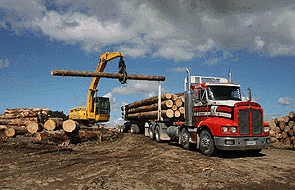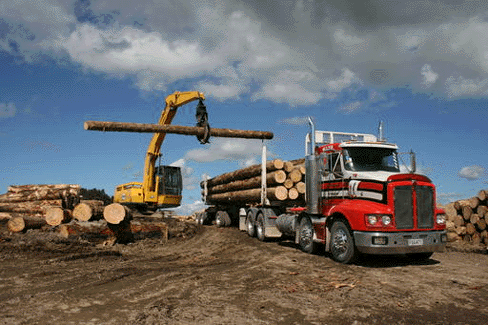

June saw another significant fall in export logs prices.
This downturn, which is more severe than initially expected, is having a big impact on forest harvesting.
Two and a half years of price rises have been lost in 2.5 months; “A” grade price has fallen $49/JAS in that time.
For those forest owners with ongoing harvesting over several years, the downturn will dramatically lower current returns, but they are likely to press on with harvesting as their returns are averaged across different market conditions.
Also, these forest owners benefit from maintaining a strong and viable contracting infrastructure (e.g. harvesting and cartage businesses).
However, scheduled start-ups of many smaller harvesting jobs are being deferred. Marginal forest blocks with prior estimates of positive stumpage returns, now look like printing “red ink”. Nobody wants to harvest a forest or woodlot after 26 years of growth to be presented with an invoice to pay.
Then there are the small-medium size harvesting jobs on the go at the moment. Again, if the market is going to result in dramatically lower (or negative) stumpage returns, many forest owners want to suspend operations. For these forest owners, the maintenance of contracting capacity is less of a concern as they may only be “in the market” once every 26 years, or even once in a lifetime.
PF Olsen is trying to keep all parties informed and we try to manage a fair process of responding to divergent needs. We are also looking closely at the market to try to determine direction and the first signs of a rebound.
At this stage there is a wide range of views of the market.
The more optimistic (and predominant view) is weakness continuing through July with an upturn in August/September.
The unfortunate reality is that many smaller harvesting jobs won’t start in this market, and some will stop. This has awful financial consequences for some contractors who recently geared up to meet the increasing demand for harvesting services.
This is the ugly underbelly of a commodity market.
It is happening in other hard commodities such as iron and coal too (e.g. in the major downturn in the Australian mining industry). While a single market - China - drives our log market, this volatility appears to be inevitable.

"The forestry industry faces a fine balance between minimising the financial damage to woodlot owners from a collapse in export log prices with the need to maintain a strong and viable contractor workforce."
In our export log market section below, we take closer look at the Indian market which has the potential to become a significant purchaser of New Zealand Radiata pine logs if it successfully reinvigorates its growth agenda.
Export Log Market
China continues to drive the market down. Since last month, log inventories over the 25 ports monitored, have increased to 4.2 million cubic metres, or about 70 days supply.
Due to considerable log volume in the pipeline (logs in transit in logging ships and logs in stock in New Zealand ports), deliveries into China’s already bloated log inventories didn’t reduce much in April/May.
Currently, however, due to a combination of very wet weather and deferred and suspended harvesting jobs, production across New Zealand is reported to be down as much as 30%.
This will make more significant headway in getting log inventories down in China. Until log inventory levels get down to around 3 million cubic metres the market isn’t expected to show any pricing strength.
Pricing differentials among different exporters and amongst ports across New Zealand have widened dramatically. Some exporters are struggling to even secure sales and have either left the market, or are offering very low prices. During the first quarter of this year when the market was strong, price differentials between main North Island ports and provincial North Island/South Island ports were $2-8/JAS.
Currently this has ballooned out to $8-$25.
Forest owners should shop around for the best deals and pay particular attention to credit security.
In contrast to a few years ago, North America has taken over Russia as New Zealand’s most significant competitor for wood to China. Predictions for the US housing market vary from 1.2 to 1.6 million new starts for 2014.
If in the lower range, supply can probably be satisfied domestically and from Canada. If in the upper end of the range, increased imports of lumber, probably from Europe (along with increased prices) will be required. More supply of logs and lumber into domestic US markets may constrain wood exports to China and improve prospects for New Zealand supply.
Growth Prospects in India Improve
India recently voted in Narendra Modi of the BJP party on a reformist, progressive and pro-economic growth mandate. Previously the governor of Gujarat, a north western state of India, Modi has successfully achieved a decisive party majority – a rarity in the highly fractious 543 seat parliament.
Over half of India’s 1.2 billion inhabitants are under the age of 25. The number of middle class families is expected to double to 580 million by 2025. By 2050 at least half a billion people are expected to have moved from rural areas to towns and cities. This growth will increase the consumption of wood, but poses a great challenge to the estimated 26,000 sawmills, many located in Modi’s state of Gujarat. Low mechanisation, outdated technology and high labour inputs characterise this sector – not unlike that of China’s sawmilling industry a few years ago.
Annually, India has imported 7.5 million m3 of logs, two-thirds of which has been hardwoods, mainly from Myanmar and Malaysia. In April of this year Myanmar banned log exports and supply from Malaysia is expected to become increasingly constrained. India is turning to softwoods to make up the volume shortfall, both in logs and lumber.
If Modi’s reformist agenda can rekindle the sputtering economic growth, there are significant opportunities for New Zealand to supply India with Radiata pine.
Infrastructure constraints such as crowded and inefficient ports are major challenges as are competitors - North America has the Indian market in its sights, and Germany has become India’s largest suppliers of softwood lumber. However, much like China, India has the potential to become a major economic powerhouse and a critically important market for New Zealand wood. The strong support for popular (albeit controversial) Mondi puts India one step closer to realising this goal.
Domestic Log Market
The domestic log market has strong demand for both pruned and unpruned structural grades and pulp logs are in strong demand in some areas – in the lower-central North Island, for example, the reduced harvesting levels are tightening up pulp log supply.
The strong property market and building activity in Auckland and Christchurch continue. The quantity of building work undertaken around the country during the March quarter was 16% higher than the December 2013 quarter. The general economy is also posting strong growth; core retail spending grew at just under 4% in the year to March; employment grew by 83,000 or 3.7% over the year to March. GDP is forecast at over 4% for 2014.
The growth boost by the strong property market and buidling and construction activity is expected to continue for some time.
Pacficon, in its National Constuction Pipeline report, forecasts unprecedented buildling and constuction activity for the next six years, peaking at $32 billion in 2016. This is 23% higher than the previous highest level of $26 billion in 2007. As expected, this is driven mainly by house construction in Auckland and the Canterbury rebuild.
This scenario provided the backdrop for the Reserve Bank to hike the Official Cash rate 0.25% to 3.25% earlier this month, with the unitended consequence of adversely affecting returns to the export sector by pushing the value of the Kiwi dollar up.
The domestic solid wood processing sector is benefiting from strong domestic demand for building and construction. Good demand from the key Australian and USA market is also being reported, although this will be adversely affected if the Kiwi continues to strengthen.
PF Olsen’s log price index fell a further $9 to $95, following a $10 fall in May. This was driven by large price decreases in export logs.
---------------------------------------------------------------
This article is reproduced from PF Olsen's Wood Matters, with permission.
We welcome your comments below. If you are not already registered, please register to comment
Remember we welcome robust, respectful and insightful debate. We don't welcome abusive or defamatory comments and will de-register those repeatedly making such comments. Our current comment policy is here.